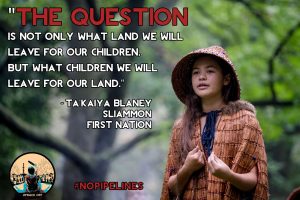Social media has created a tool for Indigenous people all over the world to organize politically that span both time and location. The Idle No More movement has been one of Canada’s most successful political movements ever to spotlight the political issues Indigenous Canadians face.
Idle No More was created by 5 Cree women who vowed enough was enough when it came to the Canadian government threatening to pass omnibus bills that would decrease pollution protection for Canada’s lakes and rivers, ignoring historic treaty promises, and dragging their heels when it comes to missing and murdered Aboriginal females.
Technology like Twitter. FaceBook, and Internet allowed this small group to organize and expand their political voices. This newspaper article from the Toronto Star traces how social media can be harnessed for maximum political power.
Here are some key quotes:
- Erica Lee, 22, is a University of Saskatchewan student who has been an activist for most of her life. People like Lee, young and tech-savvy, are the face of this movement. And social media is the tool that’s allowing them to speak, she said.
“Traditionally, it’s the chiefs and the people in power that have the ability to speak to the media, whereas now, people like me — university students who have been involved in this kind of stuff — are getting interviewed,” Lee said.
“Social media allows the people who are actually directly involved and impacted by these kinds of movements . . . to have their voices heard.”
- “It gives (people), especially in northern communities and rural First Nations communities, a chance to be connected with events and be inspired by other peoples’ events that they might not have access to, that they aren’t seeing on TV and in newspapers,” Lee said.
The Facebook page started Nov. 29 and now has more than 63,000 likes and photos from protests and rallies all over the world.
- Megan Boler, a professor at the University of Toronto who studies the Occupy movement, said “Occupy would not have taken off” without the physical encampments in public places and face-to-face contact.
“The digital divide that exists between First Nations people in Canada and those of us who are living in urban areas is huge.
“Because of that digital divide, no doubt there are hundreds of thousands of First Nations people . . . who are not expressing themselves through social media.”
This article can be used in the classroom to start investigating how social media is really changing the face of political protests and giving voice to people who in older days were silenced, ignored and oppressed.
Here is the link:
https://www.thestar.com/news/canada/2013/01/11/social_media_helps_drive_idle_no_more_movement.html
Here is the Idle No More website: http://www.idlenomore.ca/

Hi Paul, thanks for this great resource! Important in Aboriginal equality may be in the use of social media. What spoke to me was that quote: “Social media allows the people who are actually directly involved and impacted by these kinds of movements . . . to have their voices heard.” For me, that might be the piece of the puzzle that enables change.